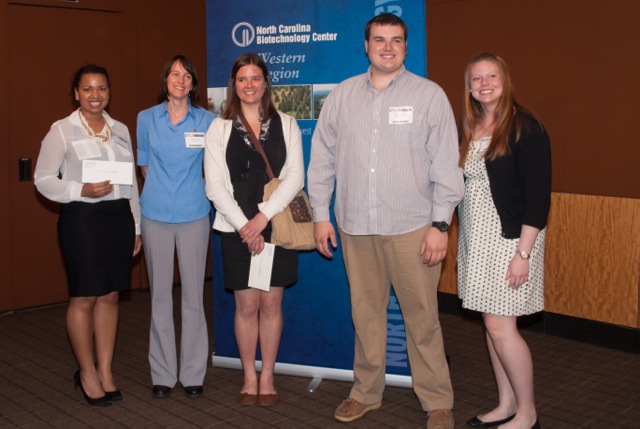
Science in the Mountains Celebrates Life Sciences in Western NC
By Jeremy Summers, NCBiotech Writer
North Carolina’s Appalachian mountains are known for majestic scenery, top-notch universities and in recent years, the growing brewery industry.
What most people don’t realize, though, is that behind every good beer is a lot of science. Brewing utilizes fermentation, the world’s oldest form of biotechnology, to add alcohol to the drink. Thanks to this growing industry, Western North Carolina is becoming known for the science that drives the brewing industry, drug discovery and other life-sciences related fields.
The science and research being developed in the region was the focus of this year’s Science in the Mountains conference, which took place April 11-12 on the campus of co-sponsor Appalachian State University.
Originated by the North Carolina Biotechnology Center, also a co-sponsor, the conference brings together local universities, government agencies and business organizations in the western part of the state. The two-day event highlighted research and commercialization of the life sciences that capitalize on western North Carolina’s unique natural resources.
Collaboration breeds success
The theme of the 2013 biannual meeting was “Thinking outside the box: The benefits of multidisciplinary collaboration.” The conference focused on the benefits made possible by collaborations among multidisciplinary research sectors. Presenters discussed the benefits of collaboration, possible funding avenues and ways to enable the exchange of data or results.
 |
The conference began with opening remarks from Susan McCracken, Ed.D., director of external affairs and community relations at ASU. McCracken began by thanking NCBiotech for its partnership with the university and the conference. “They have invested in the infrastructure and research and development for North Carolina’s biotech industry,” said McCracken. “Through their support for students and faculty, a lot of grant dollars have come...to take them to the next level.”
“Biotech can be used to help the human condition,” said McCracken. The tools of biotechnology can and will be used, she said, to help improve and protect against muscle loss, create new methods for pain treatment, use collagen to treat wounds and burns and increase knowledge of crop production, echoing the themes of the speakers and student presenters. “I am constantly impressed by what our young people are doing,” said McCracken, adding that students have “enormous contributions to make to your field.”
Collagen research vital to new treatments
Several of the conference’s presenters spoke about the potential of collagen to treat a diverse range of human health problems. Brooke Hester, Ph.D., explained that collagen is the most abundant protein in humans and is responsible for the structure of connective tissue and organs and is crucial to the process of tissue healing.
Having a better understanding between the structure of collagen and its function, she said, is not well-known at the microscopic level. Numerous benefits can be derived from a better understanding of this relationship, which is the focus of Hester’s research at ASU.
Guest speaker William J. Landis, Ph.D., of The University of Akron, echoed the importance of needing a better understanding of how collagen mineralizes bones and tissue in the body. Orthopedic doctors have long tried to explore how bones and teeth mineralize and according to Landis, collagen plays a major role in that process. Collagen, he explained, interacts with minerals to form fibers that make up tissue. Its pivotal role in these important functions demand scientists acquire a better understanding.
This better understanding, said Landis, can come from multidisciplinary research, which “pushes forward the boundaries of scientific exploration.”
Brewing up an industry
The brewing industry has been expanding at an impressive rate in Western North Carolina in the past few years.
According to Bret Taubman, Ph.D., chemistry professor in Appalachian State University’s new fermentation sciences program, the growth of Asheville as “Beer City” has been no accident.
Approximately 90% of beer is composed of water, making it the most crucial ingredient in the brewing process. Taubman teaches the university’s brewing science class and guides students as they experiment with their own beer production at the student-run Ivory Tower Brewery. One of the things that makes beers produced on campus so unique, besides the fact that students are producing them, is the town’s water quality.
The water quality in Boone is very “soft” compared to other water sources, said Taubman, due to the fact that it is sourced from the head water of three rivers surrounding the area, giving the beer Taubman and his students produce a distinctive flavor and high quality.
Most larger breweries have water sources of relatively high quality. This allows them to save time and money, since each brewery has to purify the water via reverse osmosis to free it of contaminants. Many of the distinctive beer styles world wide, such as pilsner and India Pale Ale, are determined by the water sources in the cities from which they originate.
 |
|
Poster award winners (left to right): Ayana Martin, Keri Bear Reel, Kristin Emery, Zachary Williams, Amber Harold, Takako Ohashi |
The same is true of water quality in Asheville, as the water sources for the city and the surrounding area also come from nearby rivers. According to Taubman, the cleaner water was a major component of attracting breweries like Sierra Nevada and New Belgium, since the cleaner, purer water source will mean they have much less to spend on purification of the water.
“One of the main factors for both Sierra Nevada and New Belgium is water quality,” he said. Since water comprises such a large percentage of the makeup of beer, water quality is crucial not just for the quality, but also the economics of brewing. ASU’s fermentation sciences program will serve as a support system for the brewing industry, which is accelerated and improved by collaboration. “Fermentation science is very interdisciplinary by nature,” said Taubman.
In addition to the brewing industry, fermentation impacts the food we eat. Taubman estimated that 30% of the food we consume, including wine, cheese, yogurt and coffee, has undergone some form of fermentation.
Student-made posters a highlight of conference
One of the highlights of the conference each year is the student-made poster presentations. Conference attendees had numerous opportunities to visit the poster gallery and speak with the graduate and post-doc students who made the poster presentations. These poster presentations allowed students, speakers and attendees to exchange ideas and network, which underlined the conference’s theme of multidisciplinary research.
The awards for this year’s poster competition are as follows:
Graduate/Post-doc Posters
- 1st place ($75 Amazon gift card) - With 94.67% of the vote, first place went to Zachary S. Williams from Appalachian State University for Poster #118 on the Identification and Embryonic Expression of a Highly Conserved Meis-Linked Gene.
- 2nd place ($50 Amazon gift card) - With 92.33% of the vote, second place went to Takako Ohashi from Appalachian State University for Poster #117 on the Estrogen and hypoxia regulate levels of VEGF and its receptors in the mice uterine cervix and are expressed in human.
- 3rd place ($25 Amazon gift card) - With 91.67% of the vote, third place went to Ayana Martin from Wake Forest University for Poster #106 on the Coordinated Induction of cPLA2 and COX-2 by LPS Stimulation.
Undergraduate Posters
- 1st place ($75 Amazon gift card) - With 91.00% of the vote, first place went to Amber L. Harold from Appalachian State University for Poster #201 on the High-throughput Drug Transporter Assays in C. elegans.
- 2nd place ($50 Amazon gift card) - With 90.33% of the vote, second place went to Kristin Emery from the University of North Carolina at Asheville for Poster #211 on the Analysis of Genetic Variation of the Clonal Shrub Spiraea virginiana Britton and Implications for its Conservation in Western N.C.
- 3rd place ($25 Amazon gift card) - With 89.50% of the vote, third place went to Keri Bear Reel from Appalachian State University for Poster #208 on the Redundancy and Specialization in the Arabidopsis thaliana FLIP4 Gene Family.
